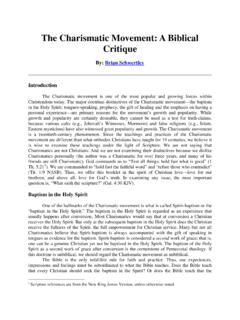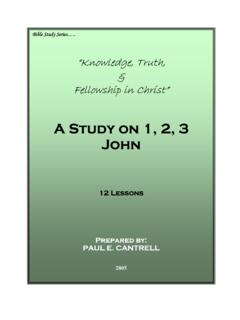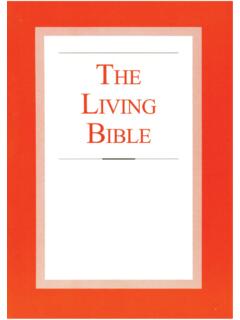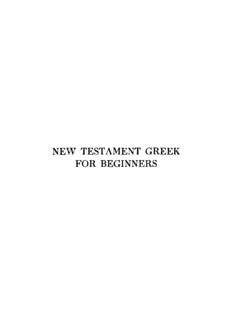Transcription of Serbian: An Essential Grammar
1 IContentsSerbianAn Essential GrammarSerbian: An Essential Grammar is an up to date and practical referenceguide to the most important aspects of serbian as used by contemporarynative speakers of the book presents an accessible description of the language, focusingon real, contemporary patterns of use. The Grammar aims to serve asa reference source for the learner and user of serbian irrespective oflevel, by setting out the complexities of the language in short, is ideal for independent study or for students in schools, colleges,universities and all types of adult of this Grammar include: use of Cyrillic and Latin script in plentiful examples throughout a cultural section on the language and its dialects clear and detailed explanations of simple and complex grammaticalconcepts detailed contents list and index for easy access to Hammond has been teaching serbian both in Serbia and the UKfor over twenty-five years and presently teaches at the Defence Schoolof Languages, Beaconsfield, Essential GrammarsEssential Grammars are available for the following languages.
2 ChineseDanishDutchEnglishFinnishModern GreekModern HebrewHungarianNorwegianPolishPortuguese SerbianSpanishSwedishThaiUrduOther titles of related interest published by Routledge:Colloquial CroatianColloquial SerbianiiiContentsSerbianAn Essential GrammarLila HammondFirst published 2005by Routledge2 Park Square, Milton Park, Abingdon, Oxon OX14 4 RNSimultaneously published in the USA and Canadaby Routledge270 Madison Ave, New York, NY 10016 Routledge is an imprint of the Taylor & Francis Group 2005 Lila HammondTypeset in 10/12pt Sabonby Graphicraft Ltd, Hong KongPrinted and bound in Great Britainby MPG Books Ltd, BodminAll rights reserved. No part of this book may be reprinted or reproduced orutilized in any form or by any electronic, mechanical, or other means, nowknown or hereafter invented, including photocopying and recording, or inany information storage or retrieval system, without permission in writingfrom the Library Cataloguing in Publication DataA catalogue record for this book is available from the British LibraryLibrary of Congress Cataloging in Publication DataHammond, Lila, serbian : an Essential Grammar / Lila cm.
3 (Routledge Essential grammars)Includes bibliographical references and 0 415 28641 7 (pbk. : acid free) ISBN 0 415 28640 9 (hardback : acid free)1. serbian language Textbooks for foreign speakers English. 2. serbian language Grammar . I. Title. II. Series: Essential 282421 dc222004010094 ISBN 0 415 28640 9 (hbk)ISBN 0 415 28641 7 (pbk)This edition published in the Taylor & Francis e-Library, 2005. To purchase your own copy of this or any of Taylor & Francis or Routledge scollection of thousands of eBooks please go to I dedicate this book toMilitca, Leo and TaraviContentsviiContentsContentsPreface xiiiAcknowledgementsxivPart I The language and its dialects1 Chapter 1 Cultural, literary and linguistic background3 Chapter 2 Dialects9 Part II Alphabet, pronunciation and stress11 Chapter 3 Alphabet13 Chapter 4 and unvoiced and hard of л/l to о of е/e and и/i on к/k, г/g andх and mutations29 Chapter 5 stress and of stress32viiiContentsPart III Parts of speech33 Chapter 6 and present tense I II III of verbs and and intransitive and perfective of the present tense and negative present interrogative negative interrogative present tense ( perfect tense)
4 Of the perfect tense and negative perfect interrogative perfect negative interrogative perfect of the future tense and its negative interrogative negative interrogative of the aorist tense and its negative interrogative negative interrogative of future of the future of the of the of the of the of the of the perfective aspect of бити/ И и/izi and its verbs101 Chapter 7 of of of of and neuter and masculine nouns ending in-a and the noun мати nouns ending in a consonant,in -o, -ост/ost or -ад/ad, and the nounк и of irregular nouns173 Chapter 8 of personal personal personal of unstressed personal pronouns199 Chapter 9 of active past of the active past passive of the passive past participle220 Chapter 10 (nominal) present verbal past verbal adverb231 Chapter 11 through the cases236 Chapter 12 in usages of што/eto and ко и/koji246 Chapter 13 and importance of enclitics250 Chapter 14 numbers and their two, three, four andthe numeral both five, six, seven and numbers and their and decimal Weights and Days, months and Telling the Time-related words and expressions280 Chapter 15 of and uncountable quantifiers285 Chapter 16 determiners291 Chapter 17 Particles.
5 Conjunctions and exclamations293 Part IV Sentence elements and structure297 Chapter 18 of a of clauses301 Chapter 19 Sentence sentences306 Chapter 20 Word purpose of this book is to offer the English-speaking student ofSerbian a thorough and accessible overview of serbian is a complex and expressive language and the scope of thisbook is too narrow to allow for sufficient examples to facilitate a moreprofound comprehension and understanding of the language. It doeshowever, strive to explain, as much as possible, the rules governingmost linguistic and grammatical conditions and is not a language of simple constructions and straightforwardexpressions, and perhaps the most important piece of advice to thestudent would be to approach his or her study of this language with acurious and courageous is a beautiful language and I compliment the student wishing tolearn HammondLondon, 2005xivContentsAcknowledgementsI wish to express my gratitude to all the people who made writingthis book possible.
6 Amongst them are Verica Stevanoviz, GordanaIliz, Miroslava Virijeviz, as well as Farret Abbas, Wayne Doran andZlata Krivokuza, who were always at hand with their support also wish to thank my students, for their patience and perseverancein studying this language and in continually challenging me to improvemy methods of explaining and defining it. I thank them especially fortheir determination in pursuing their studies during those difficult times,of which there were, and inevitably are, many. Seeing them developinto users and speakers of serbian has been a great inspiration andreward for me as a finally, I wish to thank my editors, Sophie Oliver and JamesFolan for their patience, understanding, support and trust during thewriting of this IThe language and its dialectsPart IThe language andits dialects21 Culturalbackground3 CulturalbackgroundChapter 1 Cultural, literary andlinguistic backgroundSerbian belongs to the Slavonic group of languages, which, along withthe Romance and Germanic languages, is one of the three largest groupsof the Indo-European family of Slavonic group of languages includes Polish, Czech and Slovak(belonging to the western group of Slavonic languages), Ukrainian,Belarus and Russian (belonging to the eastern group of Slavonic lan-guages)
7 And Slovenian, serbian , Croatian, Bosnian, Bulgarian andMacedonian (belonging to the southern group of Slavonic languages).In the sixth and seventh centuries, various Slavonic tribes, some ofwhich were to become the serbian nation, migrated from the north Russia, Byelorussia and the Ukraine, where they shared the land withthe eastern Slavs and travelled to the Balkan peninsula and the regionof Pannonia. At the time Bulgaria and the Byzantine Empire both wantedto occupy this region. The Slavs, themselves pagans, were also caughtbetween the Western, Catholic, and the Eastern, Orthodox religions. Inthe ninth century, serbian rulers, struggling for power, converted toChristianity and were baptised by priests from the Byzantine tribes joined together under the common Christian the twelfth century, the founder of the most significant medievalSerbian dynasty, Stefan Nemanja, expanded his lands to include Kosovoand, further, to what is now the Montenegrin coast.
8 Appointing hismiddle son, Stefan Nemanjiz, a son-in-law of the Byzantine imperialfamily, to replace him, Nemanja joined his youngest son, Sava, a monkin the Orthodox faith, to become a monk himself. Stefan Nemanjizmanaged, through clever running of the state, to fend off Serbia senemies. He managed to maintain good relations with both the Westand the East and in the thirteenth century he received a royal crownfrom the Pope, which gave him the title of Stevan Prvovenaani, the first-crowned king of father, Stefan Nemanja, and brother, Sava, built the monastery ofHilandar on Mount Athos in Greece, which became the most prestigious41 Culturalbackgroundschool for serbian monks. This monastery is of great importance in thedevelopment of the serbian church and serbian the appointment of Sava (who was proclaimed a saint upon hisdeath) as archbishop in Nicaea, the centre for Greeks in Asia Minor,the links between the serbian nation and the Orthodox tradition werefurther strengthened.
9 On Sava s instruction the Byzantine code of churchlaws and rules for use by the clergy, as well as many medical and scien-tific writings, were translated. He founded the first serbian hospitals(in Hilandar and Studenica) and was the founder of serbian literature,having written, with his brother Stefan Nemanjiz, the first originalSerbian literary work, the Vitae of St Simeon (The Life of StefanNemanja, their father and founder of the dynasty). (St Sava s remainswere burnt by the Turks four centuries later in Belgrade, where thetemple of St Sava now stands.)Although Sava s brother, Stefan Nemanjiz, had been crowned by thePope, he was under the influence of his brother and father and wantedto unify the serbian state under the Orthodox religion. The Nemanjadynasty gradually succeeded in uniting all the serbian lands and gaveto their country a strong and united church, the serbian OrthodoxChurch.
10 Culturally very active, the kingdom and church had their ownSlavonic liturgy and language (based on Old Slavonic). The translationof important Byzantine scrolls, liturgies, church laws, literary andarchitectural works was pursued and highly Nemanja dynasty continued to rule the state, and under the ruleof Stefan Duean (1331 1355), its boundaries expanded southward toinclude not only Macedonia and Albania, but regions of the ByzantineEmpire too. It covered the area from the Sava and Danube rivers downto the Gulf of Corinth, and became the leading power of the Balkanpeninsula. And as Duean elevated the serbian archbishopric to the levelof a Patriarchate, he was crowned the Emperor of the Serbs and Greeks .Duean ruled the state and set up all the major state systems andjudiciary based on the Byzantine model. And since some of his territor-ies were under the rule of custom and had never been under Byzantinelaw, he adopted an entire code of laws, under the name of DuEan sCode, in an attempt to unify the territories and bridge the gap betweenthe impoverished and the , as had the rulers before him, Duean also emulated Byzantinearchitecture and art, and the many monasteries and churches built inthe serbian state at the time are examples of a distinct serbian Byzan-tine style in both these Serbs were eventually conquered by the Turks in the fifteenthcentury.







